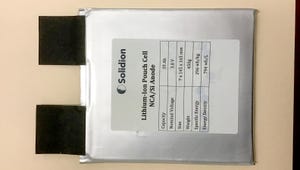Beam Global’s EV Arc Solar Charging Stations Land on Federal GSA Schedule
Federal agencies can now buy Beam’s stand-alone solar EV chargers from the General Services Administration’s Multiple Award Schedule contract.

Federal government agencies that can benefit from the availability of off-the-grid electric vehicle charging infrastructure, such as the National Park Service, now have the ability to purchase stand-alone solar EV charging stations with the click of a mouse from the General Services Administration’s Multiple Award Schedule contract site.
The GSA schedule provides federal agencies an avenue to make routine purchases without a cumbersome, time-consuming contract bidding process. An agency with the budget for a Beam EV Arc solar EV charger, starting at $61,718.44 on the GSA Advantage! site can make the one-click purchase and the charging station will arrive on a trailer, ready for use within minutes.
The Arc comprises a carport-like roof structure containing the solar cells and a base where the car parks to hold that solar cell canopy in place. The 4.3-kilowatt solar array powers the EV charger of the customer’s choice. The base price includes an ENEL Juicebox charger.
“Beam Global’s GSA Schedule now allows Federal agencies, state and local governments, educational institutions, and others to easily purchase the fastest deployed EV charging infrastructure products on the market,” said Desmond Wheatley, Beam Global CEO.
“Five federally funded National Laboratories and the U.S. Navy already use EV ARC products,” he added. But they had to go through the procurement process with bidding to get their Beam Arc charging stations. “It will be much easier to get follow-on orders from them and new orders from other Federal agencies as a result of this contract vehicle being in place.”
The incoming Biden administration’s expected EV-favoring policies make the timing of the contract award fortuitous for Beam. “We believe that the timing could not be better,” Wheatley said. “Not only do we anticipate significant federal stimulus and funding for EV charging infrastructure when the new administration takes office, we are also providing the opportunity for state and local governments to buy EV ARC products from the GSA Schedule with the Disaster Purchasing designation.”
The U.S. federal government operates the largest civilian EV fleet in the world with more than 640,000 vehicles. That count probably includes the sadly dilapidated National Park Service Neighborhood Electric Vehicle that we saw moldering at the Mathew’s Arm campground in the Shenandoah National Park during our visit to test the Lincoln Navigator’s Pro Trailer Backup Assist backup system. That vehicle’s registration was several years out of date and it appeared to have been forgotten in the campground’s parking lot, so its batteries are probably no longer functional.
But EV drivers will appreciate the potential to drive into remote areas with no electrical infrastructure without the fear that their EV will similarly become a lawn ornament for lack of electric charge.
The requirement for rapid deployment of EV charging infrastructure is expected to grow dramatically. President-elect Biden has committed to the deployment of more than a half-million new public charging outlets by the end of 2030 and to a 100 percent clean energy economy with net-zero emissions by 2050.
Beam, which is based in sunny San Diego, says the station can provide enough juice daily to propel EVs a total of 245 miles. EV Arc chargers placed in less sunny areas or during the times of the year with less daylight will experience significantly less power generation. As the car commercials say of EPA gas mileage ratings, “Your mileage may vary.”
About the Author(s)
You May Also Like





